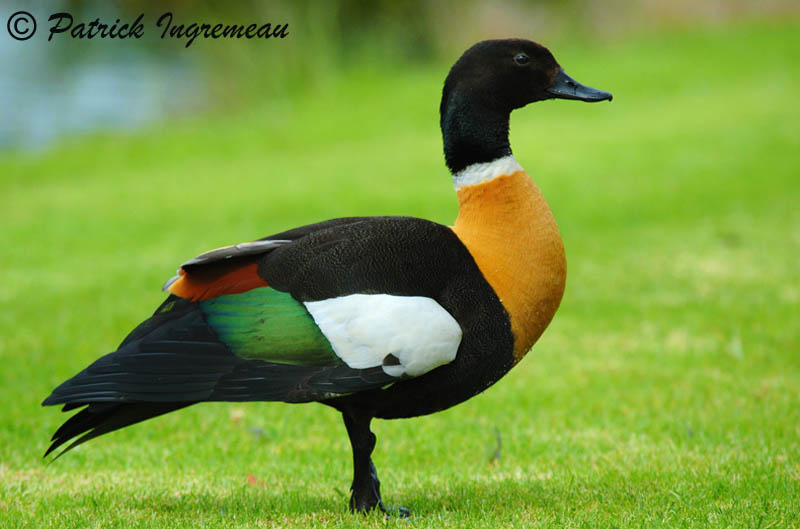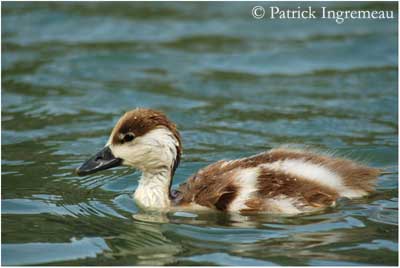
Australian Shelduck
Tadorna tadornoides
Anseriforme Order – Anatidae Family
BIOMETRICS:
Length: 55-73 cm; Weight: M : 1500g – F : 1300g
DESCRIPTION:
Australian Shelduck is large and brightly coloured.
Adult male has dark plumage in most parts of body, finely barred with grey. Head and neck are black with green gloss, and we can see white neck ring, contrasting with black head and neck. It shows sometimes a small white ring around the bill.
Upperparts are mainly black. Upper mantel is cinnamon-reddish. Upperwings show white shoulder patch, formed by white upper and under wing coverts. Flight feathers are blackish, and secondary feathers are glossy green. Tertials are reddish-brown. Tail is black.
Underparts show cinnamon breast and black belly and vent.
Bill is blackish. Eyes are brown. Legs and webbed feet are black.

Adult female is similar to male, with brighter chestnut on breast and upper mantle. White neck ring is narrower or absent. Black parts of plumage are duller and browner than in male. She is smaller. She has large white eye-ring, extending behind the eyes, and white ring around the base of the bill.
Juvenile male is duller than adults and lacks white collar.
Young female shows some whitish feathers on cheeks and around eyes.
They can breed at about 2 to 3 years of age.
Chicks are covered with white and brown down.

VOICE: SOUNDS BY XENO-CANTO
Australian Shelduck is very noisy. Male utters loud « honk », deeper than female’s call. Female utters high-pitched and resonant « ong-ank, ong-ank » and shrill « owowowo ».
Both sexes produce an assortment of goose-like honks, grunts and whistles.
HABITAT:
Australian Shelduck breeds on fresh and brackish swamps, and lakes. Feeding areas are pastures, grasslands, cultivated areas and open woodlands.
After reproduction, birds gather in estuaries and sheltered bays, and deep lakes.
RANGE:
Australian Shelduck is separated in two populations in Australia. Eastern population is relatively important, living in the province of Victoria, northwards to New South Wales and southwards to Tasmania. The other population inhabits in South- Western Australia.
BEHAVIOUR:
Australian Shelduck feeds by grazing on land or in shallow water. It is often seen in pairs. After breeding season, they gather in large flocks on water for moulting. Then, they disperse in all directions, sometimes moving long distances.
Pairs remain together year after year, and are very territorial, defending their area against other bird species. They probably return to the same nest-site every year. Outside breeding season, Australian Shelducks rest in large groups on shores, near water.
This species is fearful. When disturbed while feeding, they fly off to other area.
FLIGHT:
In flight, Australian Shelduck shows its large white patch and the glossy green speculum. In flock, they fly in long lines or in V formation.
REPRODUCTION:
Australian Shelduck prefers to nest in hollow in tree, but they also can nest in rock crevice, shallow caves, holes in banks, or even in rabbit burrows. Nest is well lined with down.
Female lays 5 to 14 creamy-coloured eggs. Incubation lasts about 30 to 33 days, by female. Male defends the nest-site and protects her.
Downy chicks leave the nest, and parents lead them through the territory when they are two days old. They remain in family group during the first six weeks. Young become independent when they fledge.
Fr: Tadorne d’Australie
All : Halsbandkasarka
Esp : Tarro Australiano
Ital : Volpoca australiana
Nd : Australische Cascara
Russe : Австралийская Пеганка
Photographs by Patrick Ingremeau
TAMANDUA
Text by Nicole Bouglouan
Sources :
HANDBOOK OF THE BIRDS OF THE WORLD vol 1 by Josep del Hoyo-Andrew Elliot-Jordi Sargatal - Lynx Edicions - ISBN: 8487334105
Wikipedia (Wikipedia, The Free Encyclopedia)
Birds in backyards (Birds Australia and Australian Museum)
DIET:
Australian Shelduck feeds mainly on short grasses by grazing, and seeds, tubers, cereals and vegetables crops. It also consumes aquatic invertebrates (insects and molluscs) and submerged vegetation, by dabbling.
PROTECTION / THREATS / STATUS:
Australian Shelduck is not very popular as game bird. But they can be killed because they damage cereal and vegetable crops when they feed in agricultural fields. Damage license is required for shooting outside open season.
Australian Shelduck populations are increasing since recent years, due to more irrigation in cultivated areas, giving them more wet areas.
